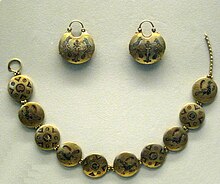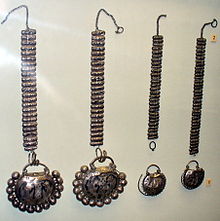A kremlin is a major fortified central complex found in historic Russian cities. This word is often used to refer to the most famous one, the Moscow Kremlin, or metonymically to the government that is based there. Other such fortresses are called detinets, such as the Novgorod Detinets.
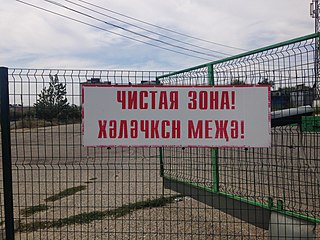
Kalmyk Oirat, commonly known as the Kalmyk language, is a variety of the Oirat language, natively spoken by the Kalmyk people of Kalmykia, a federal subject of Russia. In Russia, it is the standard form of the Oirat language, which belongs to the Mongolic language family. The Kalmyk people of the Northwest Caspian Sea of Russia claim descent from the Oirats from Eurasia, who have also historically settled in Mongolia and Northwest China. According to UNESCO, the language is "Definitely endangered". According to the Russian census of 2010, there are 80,500 speakers of an ethnic population consisting of 183,000 people.

The Russkaya Pravda was the legal code of Kievan Rus' and the subsequent Rus' principalities during the times of feudal division. It was written at the beginning of the 12th century and remade during many centuries. The basis of the Russkaya Pravda, Pravda of Yaroslav was written at the beginning of the 11th century. The Russkaya Pravda was a main source of Kievan Rus' law.
The Shor language is a Turkic language spoken by about 2,800 people in a region called Mountain Shoriya, in the Kemerovo Province in Southwest Siberia, although the entire Shor population in this area is over 12,000 people. Presently, not all ethnic Shors speak Shor and the language suffered a decline from the late 1930s to the early 1980s. During this period the Shor language was neither written nor taught in schools. However, since the 1980s and 1990s there has been a Shor language revival. The language is now taught at the Novokuznetsk branch of the Kemerovo State University.

The Solokha (Солоха) kurgan is on the left bank of the Dnieper, 18 km from Kamianka-Dniprovska, opposite Nikopol, in central Ukraine. It has a height of 19 m and a diameter of about 100 m, dating to the early 4th century BC.

There are 4 stages in the history of Yakut writing systems:
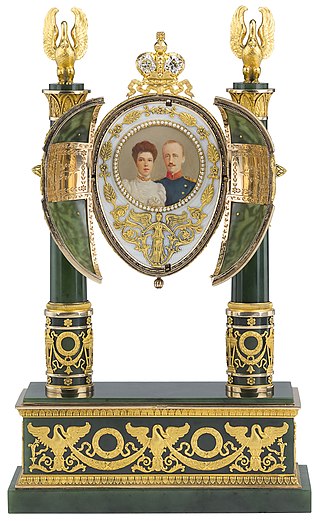
The Empire Nephrite egg is a jewelled Easter egg, purported to be one of the Imperial Eggs made under the supervision of the Russian jeweller Peter Carl Fabergé in 1901–1902 for Nicholas II of Russia, who presented it to his mother, the Dowager Empress Maria Feodorovna, at Easter 1902. This provenance has been challenged by some Fabergé experts.

Beklemishevskaya Tower is a tower at the Eastern edge of Moscow Kremlin Wall. It was named after a boyar Ivan Bersen-Beklemishev, whose house had been adjacent to the tower from the Kremlin side. It was earlier known as Russian: Москворецкая tower based its position on the near Moskva River. It is similar to the other two towers standing at the other corners of the Kremlin triangle, Vodovzvodnaya and Uglovaya Arsenalnaya rowers. While these towers are cylindrical, all other towers of the Kremlin’s Wall have been built on a square plan base.

The Ministry of Communications of the Union of Soviet Socialist Republics (USSR) (Russian: Министерство связи СССР) was the central state administration body on communications in the Soviet Union from 1923 to 1991. During its existence it had three names: People's Commissariat for Posts and Telegraphs (1923–32), People's Commissariat for Communications (1932–46) and Ministry of Communications (1946–1991). It had authority over the postal, telegraph and telephone communications as well as public radio, technical means of radio and television broadcasting, and the distribution of periodicals in the country.

The Episcopal Chamber (Chamber of Facets) is a 15th-century monument located in Novgorod Kremlin, Veliky Novgorod, Russia. It is an exceptional example of Gothic architecture in Russia, and included in the UNESCO World heritage list, along with other historic buildings in the city.

Maximilian Alexeyevich Kravkov was a Russian writer, geologist and explorer of Siberia.

People's Commissariat for Posts and Telegraphs of the USSR was the central organ of the Soviet Union government that was in charge of the organisation and administration of the different forms of communication including posts. It existed between 1923 and 1932.

Church Statute of Prince Volodimir is a source of church law in Old Rus', defined legal authority of church and legal status of clergy by the state: prince (knyaz) and his administration. Vladimir's Statute was a short legal code, regulated relationship between the church and the state, including demarcation of jurisdiction between church and princely courts, and defined index of persons and organizations within the church jurisdiction. The church also got under its supervision the system of weights and measures, and monthly support: tithe from all princely income. The statute was written at the beginning of the 12th century and remade during many centuries. The statute was written in Old Church Slavonic and [[Old East Slavic]. It was one of the first church sources of Kievan Rus' law. The Church Statute of Prince Yaroslav and other Kievan Rus' princely statutes served closely related purposes. One of the sources of the statute was Byzantine law, including the Kormchaia.

The Church Statute of Prince Yaroslav is a source of church law in Kievan Rus', defined legal authority of church by the prince (knyaz), his administration and churchmen. Yaroslav's Statute was a short legal code, regulated relationship between the church and the state, including demarcation of jurisdiction between church and princely courts, index of persons within the church jurisdiction, rules of family law and sanctions against moral violation. The statute was written at the 11th–12th century and remade during 13th–16th centuries, in Old Church Slavonic and Old Russian. It was one of the first church sources of Old Russian Law. Church Statute of Prince Vladimir and other Old Russian princely statutes served to closely purposes. But church jurisdiction was expanded in comparison with Vladimir's Statute. A part of the lawsuits in the Yaroslav's Statute was referred to the church jurisdiction, and a part - to joint jurisdiction of the church and the prince. One of the sources of the statute was Byzantine law, including Nomocanon.

Rus' chronicle or Russian chronicle or Rus' letopis is the main type of Rus' historical literature. Chronicles were composed from 11th to 18th centuries, generally written in Old East Slavic about Kievan Rus' and subsequent Rus' principalities and histories. Chronicles were one of the leading genres of Old Rus' literature, and were was prominent in medieval and early modern Eastern and Central Europe..
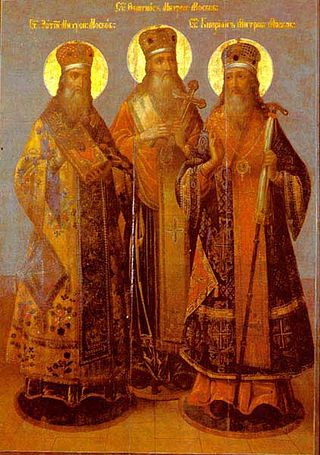
Pravosudiye Mitropolichye, lit.Metropolitan's Justice) is a source of Kievan Rus' law. It reflects the influence of the secular norms on Kievan Rus' church law.
The IZh-18 (ИЖ-18) is a single-shot, break-action shotgun.
The Komi language, a Uralic language spoken in the north-eastern part of European Russia, has been written in several different alphabets. Currently, Komi writing uses letters from the Cyrillic script. There have been five distinct stages in the history of Komi writing:
Since its inception in the 18th century and up to the present, it is based on the Cyrillic alphabet to write the Udmurt language. Attempts were also made to use the Latin alphabet to write the Udmurt language. In its modern form, the Udmurt alphabet was approved in 1937.

The Circle of Veles is an association of communities passionate about the development of Slavic native spirituality. Their patron is the god Veles, the Slavic god of wisdom. The supreme god is considered to be Rod, thus it is a Rodnovery (neo-pagan) association, common to Russia, Ukraine and Belarus.
